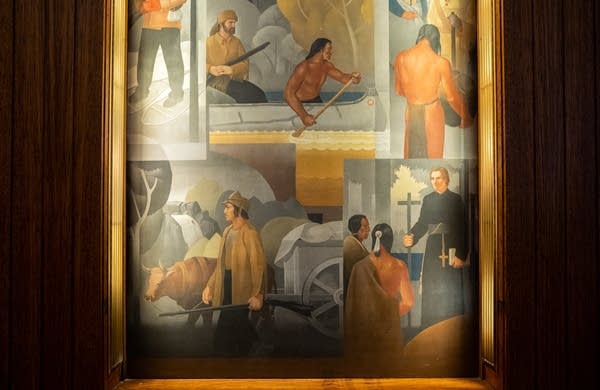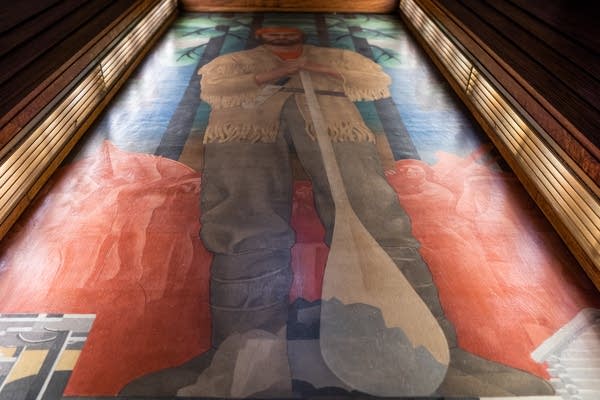Problematic St. Paul City Hall murals to be covered -- sometimes

Go Deeper.
Create an account or log in to save stories.
Like this?
Thanks for liking this story! We have added it to a list of your favorite stories.
St. Paul's City Hall is a marvel of Depression-era Art Deco architecture. Its mix of traditional woods and gleaming brass was meant to be a monument to the state's very beginnings in St. Paul, and the future its builders imagined for a modern industrial city.
But a set of historic murals dating back to the Great Depression is stirring controversy for what critics consider anachronistic depictions dominated by white men.
"That artwork really reflects the values and how our community looked and the priorities of 1930s St. Paul, [a] white male dominated community, and certainly people of color represented in servant-type roles," said Jim McDonough, chair of the Ramsey County Board, which co-owns the building with the city of St. Paul. The county manages and maintains the building.

City Hall has been listed on the National Register of Historic Places since 1983, which means there are strict regulations about what can and can't be done to the place. That includes the murals, painted by renowned Chicago muralist John Norton and practically as iconic as the onyx Vision of Peace statue in the building's main lobby. The paintings are 30 feet tall and depict an explorer, a riverboat captain, a surveyor and a railroad worker — standing atop a variety of smaller characters.
Turn Up Your Support
MPR News helps you turn down the noise and build shared understanding. Turn up your support for this public resource and keep trusted journalism accessible to all.
But while officials say the murals can't be replaced, they're prepared to offer an alternative in the historic space.
St. Paul City Council President Amy Brendmoen has pushed the effort.
"I mean as long as I have been on the council I have felt there has been a real conflict between the City Council chamber being a place where people came looking for second chances, looking for solutions to problems that they were encountering, asking for help, and then the pictures on the wall of these large, looming kind of overbearing features, standing on top of everybody else, basically," she said.

Brendmoen said she hoped to have them removed — to the Minnesota Historical Society for preservation maybe. That's what happened to a couple of paintings related to the U.S Dakota War in the 1860s — both removed in recent years from the Minnesota Capitol after much debate. Retractable covers to be drawn during meetings was another alternative she offered for City Hall.
But faced with restrictions on what they can do, the city and county say they've struck a compromise. Next month, they're establishing a joint task force to solicit new artwork that will cover the historic murals — at least temporarily. New small scale artwork will be created, then enlarged and fitted in the wall recesses where the murals are now. At any given time two murals would be covered, with two others exposed.
The plan will be to pair new paintings with a theme, like local industry or transportation, that's similar to an original mural.
"So like on transportation, a potential could be I-94 and the damage and destruction it caused to Rondo," said McDonough, referring to the once-thriving African-American community. "But that part of that collage could be the Green Line and the vitality that's come up along that."

They'll be displayed on a rotating basis, at least for the foreseeable future.
The process will include a call for artists to participate, community meetings on what people would like to see and commissions to create the art. It's expected to take about a year and run about $35,000, to be paid out of a building maintenance fund reserve.



